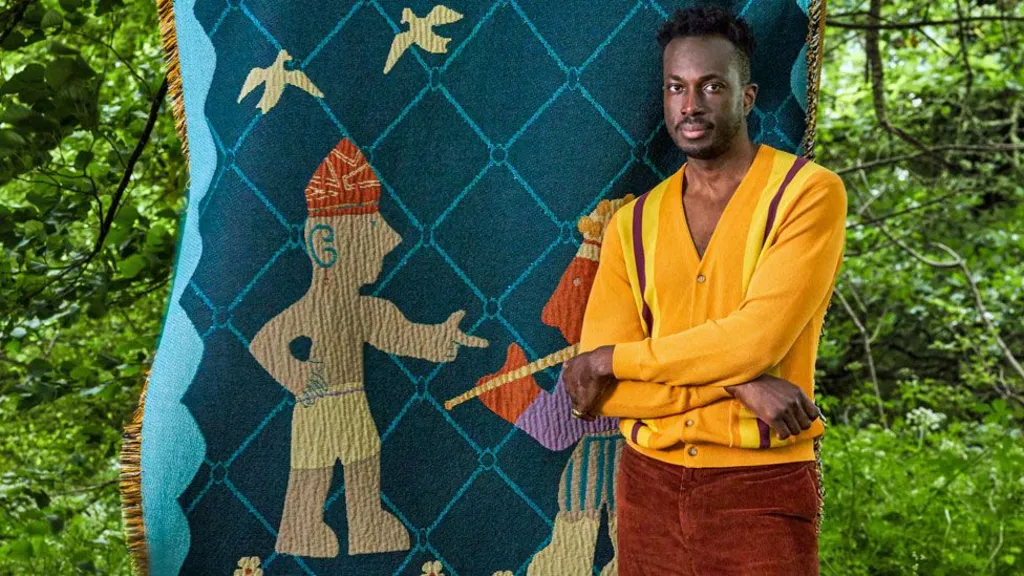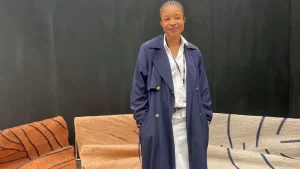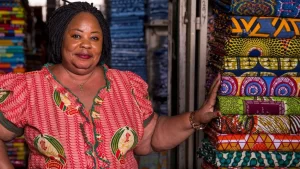Africans at the cutting edge of interior design
4 min read
This Amechi Mandi throw blanket is inspired by the historic Asafo flags of Ghana, using an applique method of layering designs

This Amechi Mandi throw blanket is inspired by the historic Asafo flags of Ghana, using an applique method of layering designs
After over a decade as a lawyer at prestigious banking firms such as Goldman Sachs and Société Générale, Nigerian-British Kelechi Ejikeme made a bold leap into the world of interior design, driven by her passion for aesthetics and culture. Her innovative rug collection draws inspiration from Nigeria’s varied landscapes—rolling hills, winding rivers, expansive savannahs, and lush forests, reminiscent of aerial views.
“When you interpret that into a rug or a carpet, it’s symbolic,” Ejikeme explained during our meeting at the Decorex interior design show in London. “It’s like, every minute, this is what we’re actually stepping on.” Each rug is crafted from jute, a sustainable material known for its durability and eco-friendliness. Jute is commonly cultivated in Nigeria for its edible leaves, particularly for dishes like ewedu soup. However, Ejikeme sources her rugs from India and Nepal, where jute is more extensively processed and established as a thriving industry.
At the same event, Amechi Mandi, a Cameroonian-Nigerian interior designer and the 2022 Rising Star awardee from House & Garden magazine, shared insights about his transition from fashion to interior design. Although he wasn’t showcasing his work, Mandi had just participated in a panel discussion focusing on the lack of authentic African-inspired interior textiles in the design industry.

With a degree in furniture and product design, Mandi had previously worked in fashion and design firms. However, he grew frustrated with the reliance on “clichéd” post-colonial motifs in African design. This discontent drove him to delve into his heritage, emphasizing pre-colonial traditions. Recognizing the fading art of indigenous textiles, particularly in the shadow of the globally popular “ankara” wax prints—often viewed as a symbol of African identity—he sought to revive these cultural elements. By integrating traditional techniques and patterns into his work, Mandi has successfully launched a collection of cushions, throws, and wallpapers that reflect his heritage with a contemporary twist.
“People have told me, ‘Oh, your work is not African,’ because they expect to see ankara prints,” Mandi noted. He draws inspiration from indigenous traditions, transforming them into modern designs. This dialogue with Mandi helped me realize my own preconceived notions about African design, heavily influenced by the prominence of ankara fabrics.
As I explored the exhibition, it struck me how the contributions of African designers often go unnoticed in such prominent spaces. Ejikeme initially balanced her legal career with her design aspirations, dedicating weekends to her true passion. It wasn’t long before she recognized where her heart truly belonged. “In one world, you’re trying to contain your energy, while in another, your expression can’t be extinguished,” she reflected.

Now a full-time designer for six years, Ejikeme has taken on diverse projects, from residential spaces to movie sets. Last year, she launched her own rug line under her Swallow and Tea studio. Despite only participating in two shows so far, she has attracted buyers primarily from Europe. “Decorex was my first UK show,” she shared, acknowledging the prevalent trend of Africans preferring international brands over local products.
Both designers observed that the African interior design scene is still in its infancy compared to the fashion industry, which has experienced significant growth. Ejikeme recalled her first independent project in 2013, aiming to create luxurious yet comforting spaces that resonated with the heritage of her African clients. “I love antiques and old designs, but there isn’t a documented history of African design,” she lamented, noting the lack of historical tracking in the field.
This realization spurred her to categorize African design periods, fostering a deeper understanding of the continent’s design evolution. Through her travels in Nigeria, including visits to galleries and markets, she began to document artifacts and styles that reflect different historical contexts, with aspirations to incorporate these elements into her projects.

Mandi emphasized that traditionally, interior design has not been a priority in African culture, which has focused more on functionality than aesthetics. He noted that the transatlantic slave trade disrupted the natural evolution of interior design practices, leaving many societies in a “constant flight” without the opportunity to develop domestic spaces fully.
Both Ejikeme and Mandi pointed out that while many wealthy Africans lack a distinctly African identity in their interiors, this is gradually changing. As disposable incomes rise, more Africans are seeking to adorn their homes in ways that reflect their personal narratives and cultural heritage. “If you create a product that is beautiful and tells a story, it will resonate with Africans and beyond,” Ejikeme affirmed, highlighting the potential for African design to flourish in the global marketplace.